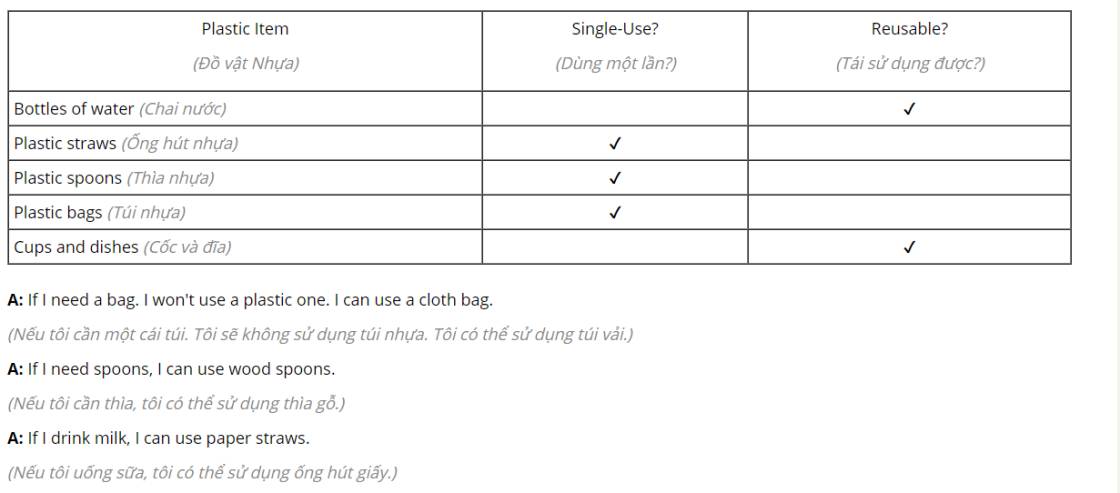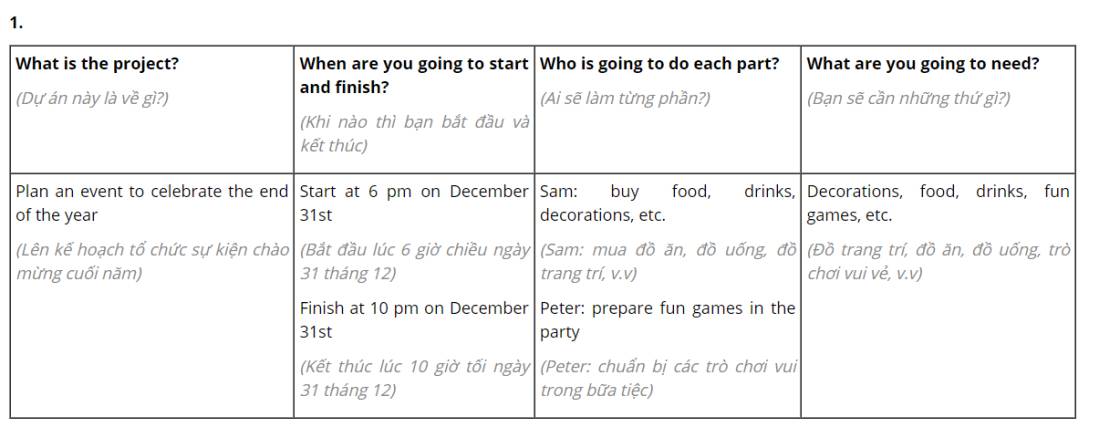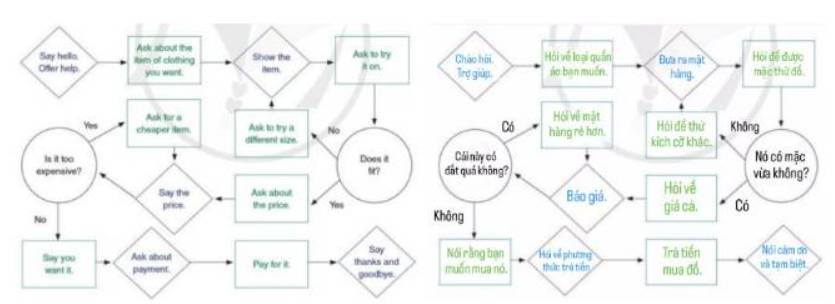Hãy nhập câu hỏi của bạn vào đây, nếu là tài khoản VIP, bạn sẽ được ưu tiên trả lời.

A: Let’s make Banh mi.
B: I need some bread.
A: Do you have any pâté?
B: Yes, I do. But I don’t have any pickled carrot.
A: I have a cucumber and chillies.
B: I need some grilled pork.

2.
- We are going to start at 6 pm on December 31st and finish at 10 pm on December 31st.
(Chúng ta sẽ bắt đầu lúc 6 giờ chiều ngày 31 tháng 12 và kết thúc lúc 10 giờ tối ngày 31 tháng 12.)
- We are going to need decorations, food, drinks, fun games, etc.
(Chúng ta sẽ cần đồ trang trí, đồ ăn, đồ uống, trò chơi vui vẻ, v.v)
- Sam is going to buy food, drinks, decorations, etc.
(Sam sẽ mua đồ ăn, đồ uống, đồ trang trí, v.v)
- Peter is going to prepare fun games in the party.
(Peter sẽ chuẩn bị các trò chơi vui trong bữa tiệc)

We are going to London, England. (Chúng tôi sẽ ghé thăm thủ đô Luân Đôn của Anh.)
We are going to visit Big Ben, an iconic landmark of London and Buckingham Palace to get a brush with the British monarchy.
(Chúng tôi sẽ đến thăm Big Ben, một địa danh mang tính biểu tượng của London và Cung điện Buckingham để tìm hiểu về chế độ quân chủ của Anh.)
We are going to stay in a hotel near the city centre.
(Ở một khách sạn gần trung tâm thành phố.)
We are going to fly there.
(Chúng tôi sẽ đến đó bằng máy bay.)

A: Your shirt looks more beautiful than mine.
(Áo sơmi của bạn trông đẹp hơn của tôi.)
B: My mother wears trendier clothes.
(Mẹ tôi mặc quần áo hợp xu hướng hơn.)
A: Today my clothes are more comfortable than mine yesterday.
(Quần áo của tôi hôm nay thì thoải mái hơn hôm qua.)
B: The clothes I wear at school are more formal than those I wear on weekends.
(Quần áo tôi mặc ở trường thì thường trang trọng hơn quần áo tôi mặc cuối tuần.)

A: Hello. May I help you?
B: Yes, I'd like to buy a shirt.
A: There is a beautiful green shirt over there.
B: I’m afraid I’m not too fond of the colour. Do you have anything less colourful?
A: Yes. Here is a white one.
B: Can I try it on?
A: Sure. Is it OK?
B: Yes, it is. How much is it?
A: It is two hundred thousand dongs.
B: OK. I'll take it.
A: Are you paying with cash or by card?
B: By card, please.

1.
- Last weekend, I went to the zoo with my friends.
- I saw many wild animals such as tigers, lions, flamingoes, etc.
- I fed the giraffes with carrots and bananas. It was such an exellent experience.
- I learnt lots of knowledge about animals.
2.
A: How was your weekend?
B: It was amazing. I went to the zoo with my friends.
A: How was the weather?
B: It was a nice day.
A: What did you do there?
B: I fed the giraffes with carrots and bananas. It was such an excellent experience. Moreover, I saw many wild animals such as tigers, lions, flamingoes, etc. After the tour around the zoo, I learned a lot of knowledge about animals. Anyway, how was your weekend?
A: It was boring. I didn’t do anything.

1)History was my favourite subject in my academic year and I have learned so many things from the history books I read and learned from teachers related to history and they were so interesting that I later did my graduation majoring History.
Learning about the past history is something that gives us real knowledge about our country, the world and about the human race. I read History in my grade 7 and found it very interesting. This subject taught us about the past of your world, how the social and economic condition was and how the world has been shaped by the different events throughout the time. After that, I become so interested in this subject that I started reading books on History from different writers. There is a famous saying that "to shape the future you must know the past" and history teaches us that. I had been lucky to have some great teachers who have a tremendous way of explaining the topics of History. To me, other subjects like literature and Math were also interesting but I felt a different passion on History.
After I finished my school, I took History as my major and that has greatly influenced me the way I look at the world and to the past and future. Reading and learning history was like travelling through time and generations that excited me so much.
2)Would your students benefit from participation in a study group? Are you too busy to organize and supervise study groups for students in your courses? I’m guessing the answer to both questions is yes. If so, here are some ways teachers can encourage and support student efforts to study together without being “in charge” of the study groups.
Promote study groups – First, include a list of reasons why students should join study groups in the syllabus or on the course website. Maybe there’s a short podcast available in which you talk about the usefulness of study groups. Better yet, if you’ve got some students who studied together in a previous course, ask them to make some comments about their experiences. Second, talk regularly in class about study groups. You can repeat all the benefits, suggest activities that involve good group study strategies, or propose some things they could study together (like problems they could solve, questions they could discuss). You also can solicit feedback from study groups in class or mention content you discussed with a group during office hours.
Make study groups an option – Encourage students to organize their own groups, but offer to help with the process. Nudge them with reminders, such as “Send me an email if you’re interested in being part of a study group.” Have study groups “register” their members, and then report on meeting times and activities. Suggest study activities for the group (ideas like those offered in the next item). Invite the group to meet with you during office hours or to send questions electronically. Offer registered study groups that report regular meetings a bonus point incentive depending on the average of their individual test grades. Let all students know that joining a study group is an option throughout the course.
Demonstrate the value of a study group – Too often when students study together, it’s pretty much a waste of time. If they’re reviewing for a test, they talk about how it can’t possibly be that hard and thereby relieve themselves of the need to study. Or they “go over” their notes, reading what they’ve written but never with any discussion. Group studying is too often accompanied by eating, texting, and regular side conversations.
In order for students to get the most value from their study sessions, you’ll need to help them come up with a different set of strategies. You can do so by holding a review session and asking students to form potential study groups (it’s up to them if they want to meet as a group more often). Give the groups tasks like these: 1) For three minutes everybody reviews their notes and lists five things they think will be on the test and then for five minutes they share lists and create a group list of the items most often mentioned. During the exam debrief, students revisit their list of things they expected to see on the exam. Were those things on the exam? 2) Everybody takes three minutes and writes a question about some content they don’t understand or wish they understood better. The group devotes a specified amount of time to each question, looking for relevant content in their notes and the text. 3) The group has 20 minutes to make one crib sheet that everyone in that group can use during the exam.
Offer proof that study groups improve performance – Compare the scores, points, or grades of those working in study groups with those who aren’t. These are data which should be collected across several sections of the course.
Define study groups broadly – Students tend to think of study groups for exam preparation, but that isn’t the only kind of student collaboration that promotes learning. If there are regularly assigned readings for the course, students can get together to discuss the reading. Again you might let them do this first in class with a good set of prompts so they see how dialogue can enrich and deepen their understanding of the assigned material. Readings are easily discussed in virtual environments, which means the group doesn’t have to find a time when everybody can meet. If various writing assignments are required in the course, students can form peer editing groups. Rubrics, checklists, and prompts can help them get beyond superficial feedback (“you might need a comma here”) to the kind of helpful critique that improves the writing.
I usually get up at 5:30 in the morning. After washing my face and brushing my teeth, I do morning exercises for fifteen minutes. Then I have breakfast with Mum and Dad at 6:15 and leave home for school at 6:30. My classes start at 7:00 and end at 11:15. After that I go home, and have lunch with my family at 12:00. After lunch I usually have a short rest. I study my lessons , read books, and do homework from 1:30 p.m. to 4:00 p.m. I often play badminton with my friends on the ground at 4:30. I come back home and have dinner at 6:00 p.m. After dinner, I often watch the news on TV for thirty minutes. Then I prepare for the new lessons and go to bed at 10:30 p.m




1. We choose to camp in the summer.
(Chúng tôi chọn cắm trại vào mùa hè.)
2. I’m going to take some T-shirts, skirts, shorts, sandals and hats because they are comfortable and cool in summer. I’m going to take a raincoat because it often rains in summer.
(Tôi sẽ mang một vài cái áo phông, váy, quần lửng, dép quai hậu và mũ vì chúng thoải mái và mát mẻ vào mùa hè. Tôi sẽ mang áo mưa vì trời thường mưa vào mùa hè.)